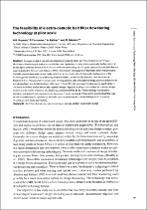JavaScript is disabled for your browser. Some features of this site may not work without it.
- ResearchSpace
- →
- Research Publications/Outputs
- →
- Journal Articles
- →
- View Item
| dc.contributor.author |
Snyman, HG

|
|
| dc.contributor.author |
Forssman, P

|
|
| dc.contributor.author |
Kafaar, A

|
|
| dc.contributor.author |
Smollen, M

|
|
| dc.date.accessioned | 2007-06-12T08:11:51Z | |
| dc.date.available | 2007-06-12T08:11:51Z | |
| dc.date.issued | 2000 | |
| dc.identifier.citation | Snyman, HG, et al. 2000. Feasibility of electro-osmotic belt filter dewatering technology at pilot scale. Water Science and Technology, vol. 41(8), pp 137-144 | en |
| dc.identifier.issn | 0273-1223 | |
| dc.identifier.uri | http://hdl.handle.net/10204/597 | |
| dc.description | Copyright: 2000 IWA Publishing | en |
| dc.description.abstract | Sewage sludge is typically dewatered using drying beds, belt filter presses or centrifuges. Mechanical dewatering of sludge is costly in terms of capital and running costs, especially the flocculent. In an attempt to address the need for more cost-effective dewatering technologies, electro-osmotic belt filtering was developed by Smollen and Kafaar in 1995. The mechanical equipment resembles a belt filter press but the belts are stainless steel, woven belts, which act as the electrodes. In this study, the feasibility of the technology was tested at pilot scale using waste activated-, anaerobically digested- and dissolved air flotation sludge. The parameters which were investigated include the applied voltage, polyelectrolyte usage and sludge feed rate. Applied voltage of between 15 and 15 volts increased the dewatering significantly in the waste activated- and anaerobically digested sludge. Applying a voltage in dissolved air flotation sludge could not enhance the efficiency of dewatering, unless stored to de-air. The technology was found as sensitive to polyelectrolyte dosages as belt presses. The performance of the electro-osmotic belt filter was sensitive to feed rate, but performed well with non-thickened waste activated sludge (0.61% solids), resulting in cake solids above 20%. | en |
| dc.language.iso | en | en |
| dc.publisher | IWA Publishing | en |
| dc.subject | Belt filter | en |
| dc.subject | Sewage sludge | en |
| dc.subject | Dewatering | en |
| dc.subject | Electro-osmosis | en |
| dc.subject | Wastewater sludge | en |
| dc.title | Feasibility of electro-osmotic belt filter dewatering technology at pilot scale | en |
| dc.type | Article | en |
| dc.identifier.apacitation | Snyman, H., Forssman, P., Kafaar, A., & Smollen, M. (2000). Feasibility of electro-osmotic belt filter dewatering technology at pilot scale. http://hdl.handle.net/10204/597 | en_ZA |
| dc.identifier.chicagocitation | Snyman, HG, P Forssman, A Kafaar, and M Smollen "Feasibility of electro-osmotic belt filter dewatering technology at pilot scale." (2000) http://hdl.handle.net/10204/597 | en_ZA |
| dc.identifier.vancouvercitation | Snyman H, Forssman P, Kafaar A, Smollen M. Feasibility of electro-osmotic belt filter dewatering technology at pilot scale. 2000; http://hdl.handle.net/10204/597. | en_ZA |
| dc.identifier.ris | TY - Article AU - Snyman, HG AU - Forssman, P AU - Kafaar, A AU - Smollen, M AB - Sewage sludge is typically dewatered using drying beds, belt filter presses or centrifuges. Mechanical dewatering of sludge is costly in terms of capital and running costs, especially the flocculent. In an attempt to address the need for more cost-effective dewatering technologies, electro-osmotic belt filtering was developed by Smollen and Kafaar in 1995. The mechanical equipment resembles a belt filter press but the belts are stainless steel, woven belts, which act as the electrodes. In this study, the feasibility of the technology was tested at pilot scale using waste activated-, anaerobically digested- and dissolved air flotation sludge. The parameters which were investigated include the applied voltage, polyelectrolyte usage and sludge feed rate. Applied voltage of between 15 and 15 volts increased the dewatering significantly in the waste activated- and anaerobically digested sludge. Applying a voltage in dissolved air flotation sludge could not enhance the efficiency of dewatering, unless stored to de-air. The technology was found as sensitive to polyelectrolyte dosages as belt presses. The performance of the electro-osmotic belt filter was sensitive to feed rate, but performed well with non-thickened waste activated sludge (0.61% solids), resulting in cake solids above 20%. DA - 2000 DB - ResearchSpace DP - CSIR KW - Belt filter KW - Sewage sludge KW - Dewatering KW - Electro-osmosis KW - Wastewater sludge LK - https://researchspace.csir.co.za PY - 2000 SM - 0273-1223 T1 - Feasibility of electro-osmotic belt filter dewatering technology at pilot scale TI - Feasibility of electro-osmotic belt filter dewatering technology at pilot scale UR - http://hdl.handle.net/10204/597 ER - | en_ZA |






